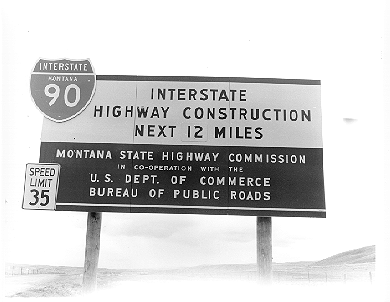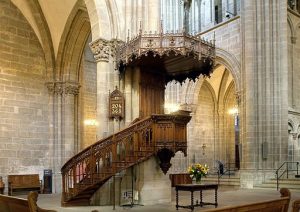
Last week, as Advent began, the lectionary Gospel turned our focus from the present to the future. If we were expecting something about a baby in a manger we were disappointed. We were firmly planted in this present troubled world, looking for Christ’s coming at the end of the age.
On the Second Sunday of Advent we turn to the past — but still we are nowhere near Bethlehem.
We take just one step backward, from the present day to when Jesus was an adult and John the Baptist was preaching about major highway construction.
Luke 3:1-6
What defines Advent waiting in the second week? We wait, with John the Baptist, for Jesus to begin his public ministry.
Perhaps this is the most familiar place to be. (It seems the lectionary thinks so, since we’ll be here again next week.) By focusing on the coming of the grown-up Jesus we remember our own situation in life
We are like the crowds in the Gospels, longing for Jesus to do for us what he did for so many: teaching, healing, feeding, welcoming us in our places of deepest need.
Real Life
Luke writes the story in a way that shows he’s grounded in real life. Historians may have to wrangle a bit about his references, but he tries to be absolutely specific about when these events happened:
- He names the emperor.
- He names the governor.
- He names three local regional rulers.
- Then, for those who are tuned in to the Jewish religious context, he names the two high priests.
Message:
I am not making this up.
Luke doesn’t want you to mistake the stories of Jesus for a fairy tale.
Don’t get me wrong, there is a sense that the Gospel stories have the power of myth. By that I mean the stories speak to our deepest needs and the true nature of human experience. That’s the reason ancient myths keep getting retold.
But in the case of Jesus, as C.S. Lewis found to his delight, the myths really happened. Luke is clear: These stories took place in real life, in history, in your world and mine.
John the Baptist, John the Prophet
And what happened? The Word of God came.
Actually that’s how John’s Gospel began too — but Luke is saying something totally different.
In John the Word came in a way that had never happened before:
And the Word became flesh and lived among us…” (John 1:14 NRSV)
— Meaning Jesus.
In Luke the Word came in a way that was quite familiar to the Jewish people:
…the word of God came to John son of Zechariah in the wilderness.” (Luke 3:2 NRSV)
— Meaning John is a prophet, and God sent a message to and through him.
John is remembered by the Church as the last of the Prophets, a sort of hinge figure between the Old Testament and the New.
So at this very particular point in real human history, one last time, the Word was sent to a servant of God.
The prophets had multiple agendas.
- They had things to say about how people were living right there in that time.
- And they had things to say about the future hope of God’s people, especially their hope for God’s anointed one, the Messiah or Christ.
John is very much the same.
1. Our lives are a mess — that’s his message to his own “here and now.”
John was
…proclaiming a baptism of repentance for the forgiveness of sins…” (Luke 3:3)
The fact that his preaching was for the forgiveness of sins meant that people had done wrong, harmed their relationships with God and with one another — and we still do. We need to be washed clean, to heal and restore those relationships, as John showed in the washing of baptism.
The fact that he preached repentance meant people had to change — and we still do. We need to change our thinking, our understanding of ourselves, of our behavior, of our God. And that change of mind has to lead to change in our living.
2. Christ is coming — and unlike in Isaiah’s time, the Big Event was days away.
John and Jesus were relatives. They had been in their mothers’ tummies at the same time. And as Luke tells the story, John in utero had actually recognized Jesus in utero (Luke 1:41).
(Which, by the way, Martin Luther once noted as an example of faith in utero and therefore an argument for the legitimacy of infant baptism.)
So presumably John and Jesus had been in consultation. John was stepping into his public ministry of preaching and baptizing specifically to prepare for the public ministry of his cousin.
Getting a Clear View
Then Luke gives us a tidbit of John’s preaching. It sounds like a major construction project.
- The hills? Mow them down.
- The valleys? Fill them up — presumably with the rubble from the mountains.
- The roads? Straighten out the crooked bits that used to go around the mountains or along the rivers in the valleys.
But why?
So that everyone can SEE Jesus coming.
Alluding to Isaiah 40:5, John says the leveling and filling and straightening and smoothing of things is so that
… all flesh shall see the salvation of God.” (Luke 3:6 NRSV)
The Word had become flesh back when Jesus was born. Now this Word-made-flesh was coming out into the world to teach, and heal, and feed, and welcome all. John didn’t want us to let anything block our view — nothing in our lives, and nothing in the structures of the world.

It reminds me of the ways 16th century Reformed Christians altered the architecture of the medieval Catholic church buildings they inherited.
In medieval Catholic worship, preaching wasn’t a big deal. It rarely even happened. The Mass focused on the Eucharist. The seating was arranged to see the altar where the priest would, at the crucial moment, hold up the consecrated elements, the Body and Blood of Christ.
For the Reformed, the main event in worship was the preaching of the Word. The Eucharist was typically celebrated only quarterly.
So for Reformed Christians to have a worship service they needed to be able to hear the preacher.
And in an age with no amplification, to hear the preacher they needed to see the preacher.
So they built these enormous pulpits and placed them prominently, arranging the seating for the best view.
The seeing and hearing of any particular sermon was a big enough thing to rework the architecture of a church. The Word was coming near and, like John and Isaiah, they really believed that all flesh should see it together.
In Advent we need to consider what in our lives needs leveling, and what needs filling, and what needs straightening. We need to be able to see him coming.
++++++++++++
Know someone who has to preach their first sermon? Have them check out my new mini-course up there in the top menu (or through this link). I’ll help them get from here to Sunday in five manageable steps.

I had to recheck my calendar when I got to the office this AM. I knew the last part of Luke 1 was the Lectionary reading, I did not realize that the passage you reflected upon was also part of it.
Thanks Steven–
Week 1 was Luke 21. Weeks 2 & 3 are Luke 3. On Advent 4 we finally get Luke 1!
I can’t find the Children’s homily for Luke 3:1-6 for tomorrow. Is there one from you?
Your lessons are a huge help to me.
Thanks
Hi Stephania!
Sorry for the delay. Here you go…
Blessings,
Gary